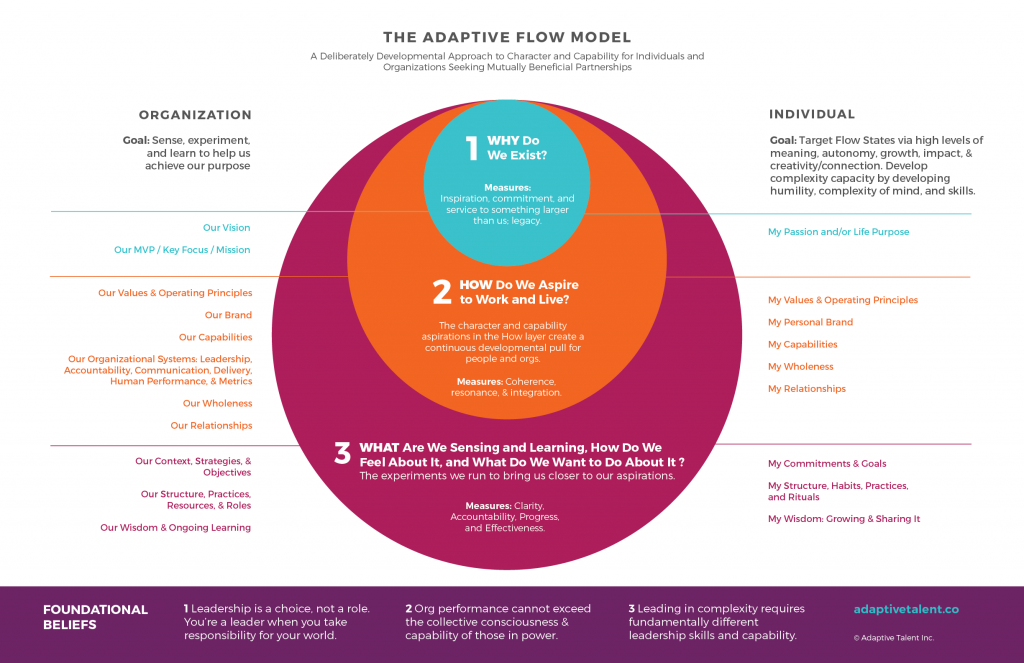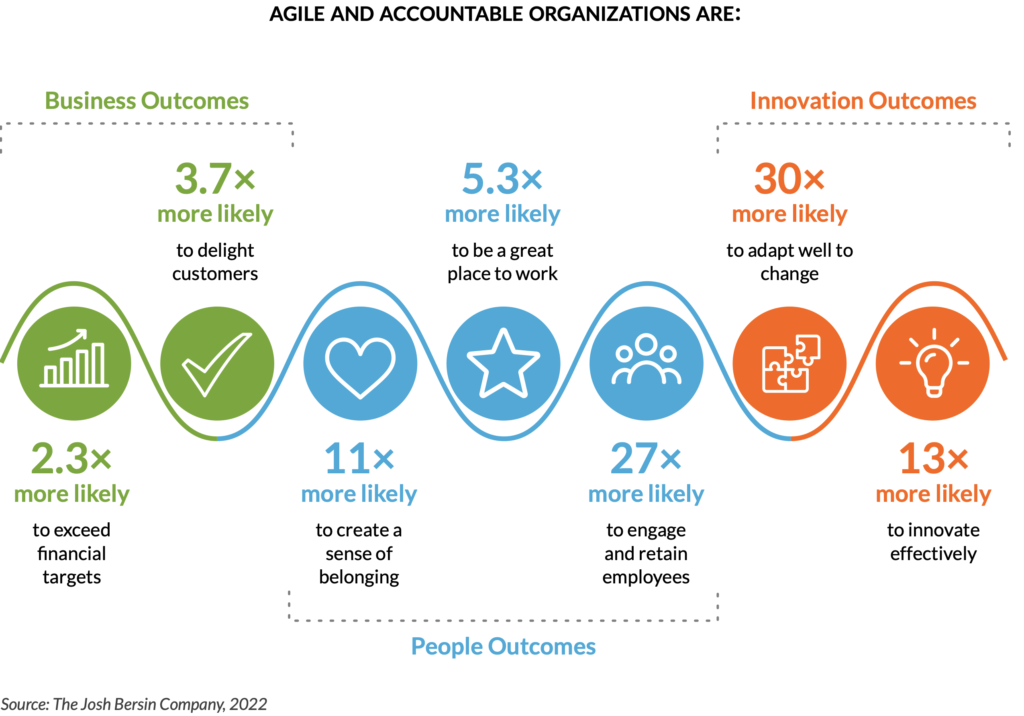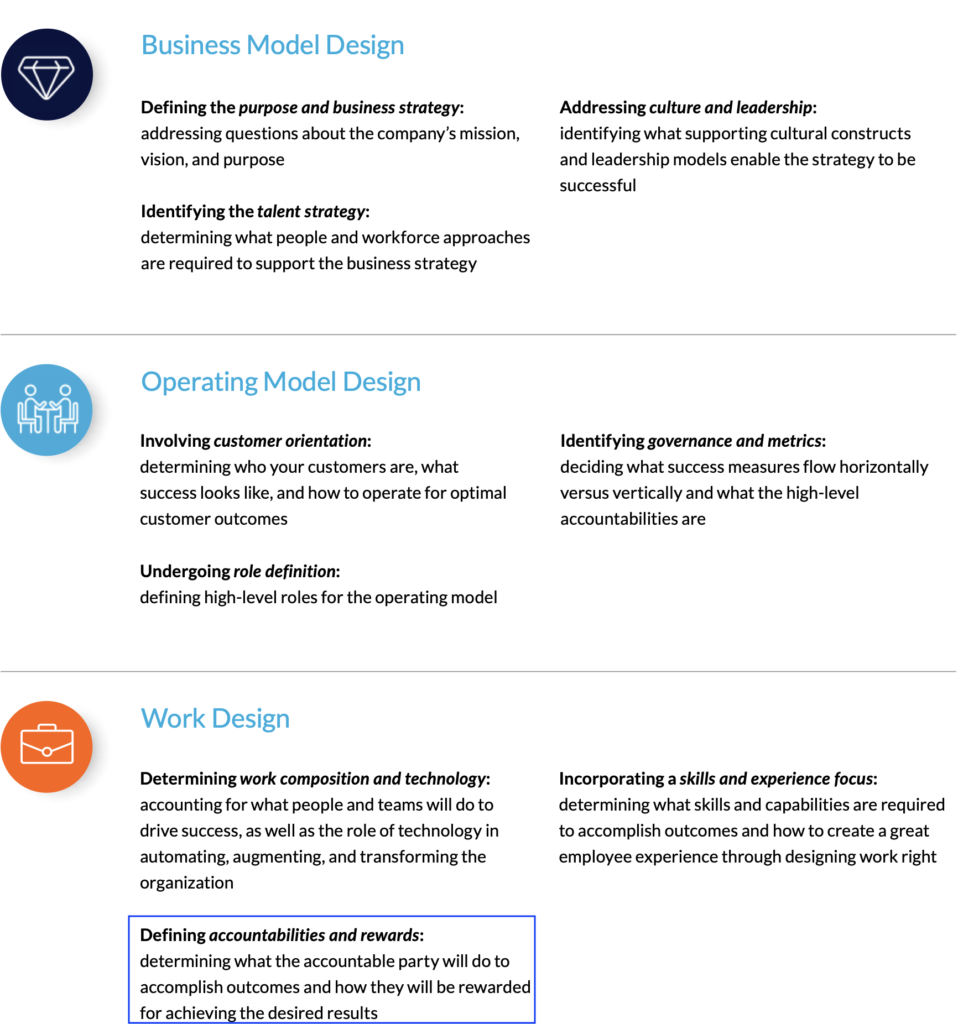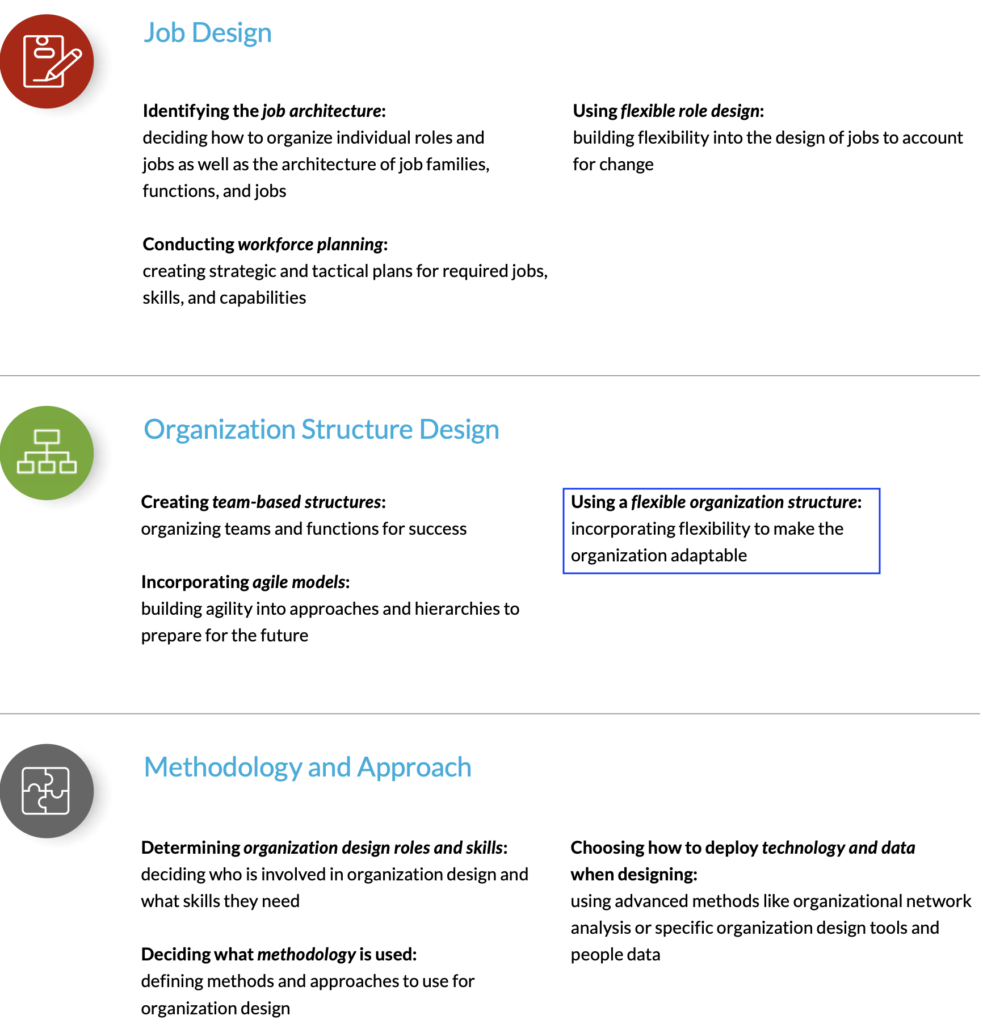 Longtime readers of this blog may recall that I introduced the concept of an organizational framework back in 2016 (see “The Adaptive Flow Model” graphic to the left) as a way for me to try and synthesize everything I was learning about adult and organizational development, complexity, adaptability, and the ideal partnership with your employees into something that people could customize for their organizations to create something cohesive and effective versus a bunch of concepts wedged together.
Longtime readers of this blog may recall that I introduced the concept of an organizational framework back in 2016 (see “The Adaptive Flow Model” graphic to the left) as a way for me to try and synthesize everything I was learning about adult and organizational development, complexity, adaptability, and the ideal partnership with your employees into something that people could customize for their organizations to create something cohesive and effective versus a bunch of concepts wedged together.
Obviously the pandemic gave us all a master class on adaptability, business redesign (and perhaps even the pain of silos if you got to experience the many transfers from one specialized customer service agent to another in order to solve your issue), and resiliency and I see no indication that these forces are slowing down anytime soon. I was therefore excited in an HR geeky kind of way to see the Josh Bersin Company’s recent publication entitled “The Definitive Guide to Organizational Design: A Journey to Agile.” It’s comprehensive at seventy pages and can give you the tools to self-assess the maturity of your organization’s approach to designing work (not the traditional boxes on the org chart) and some handy tips on how to do it.
I also just read Marcus Buckingham’s new Harvard Business Review article on “Designing Work That People Love” which in many ways spoke to my design goal for individuals as part of the Adaptive Flow Model: design for flow states. Basically my thesis was, and remains, that a company’s ability to sense, experiment, and learn quickly is key to its ability to execute and adapt (the most important polarity) and that the best way to do that is to attract and retain people in a deliberately developmental, purpose and values aligned, mutually beneficial partnership where employees are in a flow state as often as possible.
Of course that is an impossible task for any manager to achieve so the proper ownership must always be with the employee in service of creating results that matter to the rest of his/her teammates. I think this approach somewhat avoids the predictable predicament that many employers find themselves in when trying to keep employees “happy” or growing in whatever way the employee deems correct. It is why you will see the “WHAT” layer in my model as being the most dynamic of all the layers because that’s where the action and experimentation comes into play.
This includes “structure, practices, resources, and roles” which in combination with a team’s “wisdom & ongoing learning” allow coherent experiments to achieve results now and in the future (which is another way of saying adaptable). You cannot run the pace and breadth of experiments required to navigate today’s challenges from a command and control orientation without the executive team becoming a bottleneck and burned out; there’s simply too much complexity for any one group to handle this. It becomes essential to intentionally develop your people’s ability to sense, experiment, and learn at the individual, team, function, and cross-functional levels so that collectively every employee in the company is helping create results that matter. Today’s blog post will highlight some of the more salient points from the Bersin white paper that can help an executive team approach organizational design.
Why Focus on Organizational Design?
The first thing to note is that organizational design is not just the traditional boxes on an organizational chart; it is the actual design of the work, team design, process, and accountability that matters most. However, because of the rapid pace and complexity of the business world you can see that as companies become much better at agile organizational design there are significant benefits to the business. If your business model is rapidly evolving, or being disrupted by an upstart competitor with superior technology, or you’re struggling to recruit or retain people, or really if any measure of business success seems fleeting, then it is well worth the effort to explore how structure may be determining your performance.

Here are some definitions important to Bersin’s model:


What’s Different?
Unlike the traditional functionally organized model which requires horizontal integration in order for the desired results to be created this approach starts at a more nuanced level by asking about the desired customer experience and integration of any key cultural principles as a starting point. This is where I see leaders struggle because while someone or a leadership team can value certain things (the value of accountability is a crowd favourite, for example) the application of that value into principles that can inform the desired customer, partner, employee, or even community experience is harder to define. According to the inspirational Ray Dalio, “a principle is a smart way of handling something in similar situations that happens over and over”. It’s a rule or guide that helps inform one’s behaviour, and when it comes to company values it can help leaders align expectations about desirable priorities, trade-offs, and leadership. Principles are helpful as a design tool as a company grows and expands if used widely as a teaching tool (onboarding, leadership development, internal communications, etc.) because the more the executives speak to it the more people share the same meaning and can make aligned decisions.
What Matters Most?
According to Bersin the two most important factors when designing your organization are (a) accountability and rewards and (b) a flexible organizational structure. In their experience “While companies today are very clear about what business they are in, they struggle to define what success looks like, who is accountable for what, and how people are supposed to do their particular jobs.” In my nearly 30 years in People & Culture work I have found that alignment and accountability are the two hardest tasks for any leader as their teams grow. To be responsive at all layers of the organization requires alignment (strategic, cultural, operating model, business priorities, etc.) and accountability (who is doing what, to which markers and measures of success, by when, with which resources and dependencies, and predicative measures of performance against goals so no one is surprised) which is no easy feat when you get beyond a small group of people especially people earlier in their careers or those who may not care or be able to fully understand and integrate the various factors into shaping their decision.
One emerging trend is separating project management from people management so people have a consistent “home room” manager over time who is accountable for developing professional excellence, employee engagement, deployment/utilization, and of course retention. As we automate more and require more cross-functional teams to do the “human and creative” entrepreneurial work this kind of specialization will become more common and important. When you combine that with talent marketplaces like Gloat or Eightfold AI you stand a much stronger chance of employees owning their development and satisfaction, and your organization staying current on the most important skills to develop currently and in the near-term (they actually aggregate skills from all customers so you can see which are emerging requirements in job postings for similar grouping of skills to other roles in your organization; it’s a bit awe inspiring).
Finally, of course, involving your employees in this kind of work up front and throughout the process is key because they know what is working, who needs to be involved, and where customers get lost, frustrated, or even where new services or opportunities exist. They can help you design how the work is done to boost employee satisfaction and effectiveness, and when you combine that with leadership, business, and skill development you end up with people who “get” the business and are capable of leading themselves, the teams, and adapting as needed.

Where Do You Start?
Once you and your fellow leaders (whoever needs to be part of this effort) have read the report, my advice is to first self-assess where your organization fits on the maturity curve and then decide where you might experiment. Do not try and solve the hardest challenges initially; it’s important for the group to understand this is about the journey together to learn and become more effective at executing and adapting. The table below gives you the most important places to start, and I’d also recommend complementing this work with group coaching so that people can simultaneously develop their leadership and business acumen while experimenting with organizational design.
Image credit and thanks to Duy Pham
---
Adaptive Talent is a talent consultancy designed to help organizations achieve amazing results and ongoing adaptability. Founded in 2008 and based in Vancouver, Canada we offer retained and contingent search, assessments, training, leadership coaching (1:1 and group), leadership development programs, and culture & organizational development consulting.


